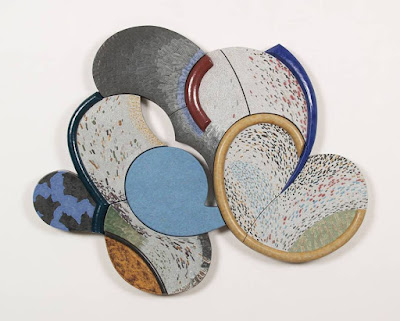INTERVIEW: A Conversation with Ken Vavrek
Ken Vavrek’s 40-year retrospective opened last Thursday in
the List Gallery. Vavrek, a retired
professor at Moore College of Art and design, creates sculptural works that are
reminiscent of antique Roman mosaics even as the bold forms echo modern artists
such as Kandinsky. I caught up with the
artist before his lecture before Thursday’s opening reception, and got the
inside scoop on his life and work.
“Ken Vavrek: Selected Works 1975-2015” runs until February 28, 2016.
Untitled 1213, 2013
I On the Arts: So
my first question: how did you get started in your career as an artist? What
made you decide to become an artist?
Ken Vavrek: I
went to college and enrolled in the art education curriculum, because I thought
I could learn enough about art that I could teach it, like in high school or
middle school or something like that. I
was not thinking so much about becoming an artist—I was thinking about becoming
an art teacher. [Well,] if you mess around in [art] long enough, you start
thinking of yourself as an artist.
IOtA: You fall in love?
KV: Well, it’s a
distinction about how you view your life. And eventually, I thought of myself
as an artist who teaches; when I started [out] I was a teacher who could teach
art.
IOtA: So did you dabble
in art when you were a kid?
KV: Oh, as much
as any other kid did. [When I was in high school,] I made mobiles.
IOtA: Oh, like
Calder?
KV: Yeah!
IOtA: Cool!
KV: When I was
doing it, I was just making something that I enjoyed making, and it was a
challenge that I was not thinking of as “great art”. But I did eventually realize that what I was
doing was pretty cliché, and that most of them were rip-offs of Calder…
(laughs)
IOtA: It’s kind of hard
to avoid that!
KV: Yeah
(laughs)… After [that,] I went off to Case Institute of Technology to become an
engineer. So I took a little path over [there,] and eventually got over to the
art education path.
DK: So do you still
draw upon your engineering training?
KV: No, I did my
freshman year and then I dropped out […] And then I was out of school for a
couple years. When I went back, I had gone through a succession of thoughts about
what I was going to do, and I ended up going into art education, because during
those two years [out of school] I was doing some teaching and I found I liked
it […] so I have forty years of teaching, and I’ve been retired for twelve
years—thirteen years, now. So the show that’s down there [in the List Gallery]
is because I had that concentrated time that allowed me to develop more
significantly.
DK: So this is a
pretty broad retrospective, right, it’s from 1975 to 2015. How would you say
your artwork has changed?
KV: Well, it’s
changed quite a bit. I went through three periods in those forty years.
IOtA: Any “Blue”
periods?
KV: No, but it
starts off with the “Desert Period,” then “Sculptural Abstractions”; my current
period I call “Pictorial Abstractions.”
IOtA: Can you talk
about any teachers or mentors you had who might have been particularly
influential?
KV: Certain
artists were influential. My mentors, my teachers—that’s a long time ago. And
they were important then […] but eventually I got to the point where I had
assimilated all of that into myself and the way I worked. So then, it would be a matter of which
artists were doing something I felt in tune with in some way, and sometimes I
would incorporate [them] and I wasn’t conscious of it, and sometimes I would
play with it, consciously aware that I didn’t want to mimic it, but I wanted to
see if I could use it.
IOtA: So which artists
would those be?
KV: Frank Stella
is one. He was doing minimalist [works] when he started off, and now he’s doing
maximalist [works], so that was a very significant change. And he is a mentor, in a sense, because I
said, “if Frank Stella can change, I can change.” Of course, I would have
changed even if Frank Stella hadn’t changed.
IOtA: Does he know he’s
a mentor figure to you?
KV: (laughs) Oh,
no…
IOtA: What would you
want someone who sees this show to take away?
KV: One of the
things that I hope for when I go into my studio is that I’ll create something
that day that gives me a boost the way art has given me a boost. And then what I would hope for is that an
audience member might get that boost from it.
There have been works of art that have just made my day—[art can be]
effective as a positive force in a person’s life, and that’s one of the reasons
you have an art department on this campus, and the reason why you have the
Calder out there [by the Science Center], because everybody loves the Calder. When you go by the Calder, you see it
bouncing around in the wind—it’s dancing for you, and that’s kind of nice.

Comments
Post a Comment